Something went wrong!
Hang in there while we get back on track
Best attractions in Ravenna
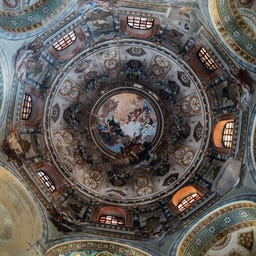
The Basilica of San Vitale in Ravenna is a masterpiece of early Christian architecture, renowned for its magnificent mosaics. This unique building, dating back to the 6th century, blends Western and Eastern architectural styles in a truly exceptional way. Upon entering this octagonal gem, you are immediately struck by the vibrant colors and intricate depictions of biblical scenes.
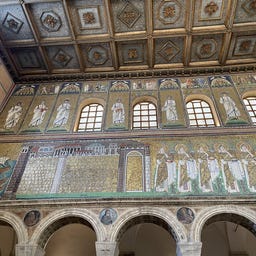
The magnificent 6th-century basilica, just a ten-minute walk from the old town, is one of the area's absolute highlights. Originally built by King Theoderic as an Arian palace chapel, it was later consecrated as a church in 561 under Byzantine rule. The basilica is renowned for its impressive mosaics, with the upper rows vividly depicting 13 scenes from the life of Christ and the Passion. The walls showcase a long procession of saints and martyrs, a true feast for the eyes. These mosaics, blending Arian and Orthodox iconography, create a unique and captivating artistic treasure.
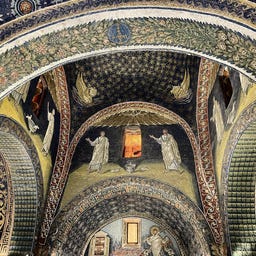
The Mausoleum of Galla Placidia, is a true surprise when entering the unassuming, small building. With its stunning deep blue starry night sky mosaic, the building stands as a testament to artistic brilliance. The empress Galla Placida was responsible for the rich art we can find today in Ravenna.
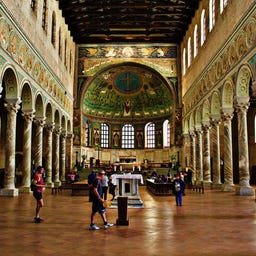
Located 8 km south of Ravenna, the basilica is an outstanding example of early Christian architecture and a UNESCO World Heritage Site. The apse and the triumphal arch are among the largest and most beautiful preserved mosaic surfaces from the 6th century.
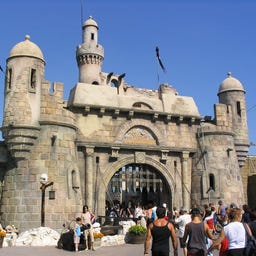
Italy's largest amusement park, Mirabilandia, spans an extensive area of 850,000 m² near the Adriatic coast. Since its opening in 1992, the park has continuously evolved and now features 42 attractions, including nine roller coasters and the impressive Eurowheel, which stands at 92 meters tall and is one of the park's landmarks.
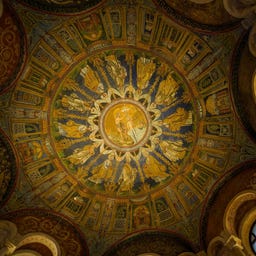
Built in the early 5th century, the octagonal Baptistery of Neon is now one of the most significant early Christian structures in Ravenna and is part of the UNESCO World Heritage. While the exterior of the baptistery is quite simple, inside you will find an impressive mosaic ensemble featuring the central depiction of the Baptism of Christ in the dome. Named after Bishop Neone, the building symbolizes resurrection and is located about two meters below street level today, blending classical and Byzantine art. In concentric rings, the mosaics display biblical figures and the twelve apostles, framed by intricate ornaments and draperies.
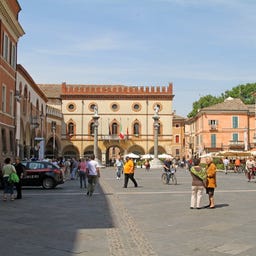
On the Piazza del Popolo, the central square of Ravenna, the city's rich history is particularly impressively reflected. Since its creation in the late 13th century under the rule of the Da Polenta family, the square has undergone numerous architectural transformations - from a Venetian palace to the current Palazzo Comunale.
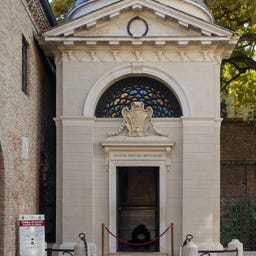
In the Tomb of Dante, a neoclassical mausoleum in the heart of Ravenna, rests one of Italy's most significant poets: Dante Alighieri, who found his final resting place here in 1321. The simple structure, designed by architect Camillo Morigia in the late 18th century, houses a Roman sarcophagus containing the poet's mortal remains and is topped by a small dome adorned with pine cones.
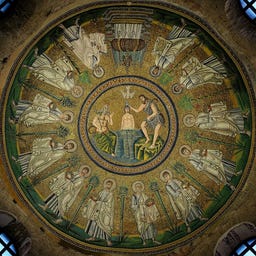
In the early 6th century, the Ostrogoth king Theodoric the Great had this unique baptistery built as a church for Arian Christians. The octagonal brick structure features magnificent mosaics under its dome, depicting the baptism of Christ, the twelve apostles, and the Holy Spirit as a dove. As the only surviving Arian baptistery in Italy, it stands as a testament to the remarkable time when Arians and orthodox Christians lived side by side in Ravenna.
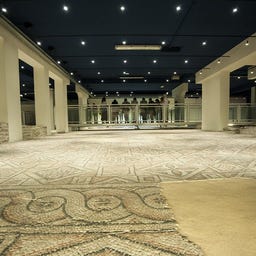
Three meters beneath the Church of Sant'Eufemia in Ravenna lies one of the most fascinating examples of Byzantine mosaic art from the 5th to 6th century. Discovered by chance in 1993, this site spans 700 square meters and impresses with its exceptionally well-preserved mosaics and marble inlays.
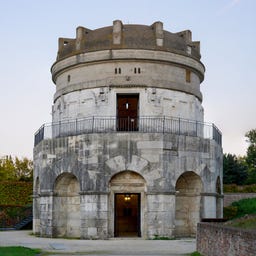
The Mausoleum of Theoderic, built in the 6th century, is one of the most significant UNESCO World Heritage sites in Ravenna and impresses with its unique architecture made of Aurisina stone. The decagonal structure, commissioned by Theoderic the Great or his daughter Amalasuntha, consists of two levels and is topped by a massive monolithic roof that, with a diameter of 10.76 meters and a weight of 230 tons, continues to baffle experts today.
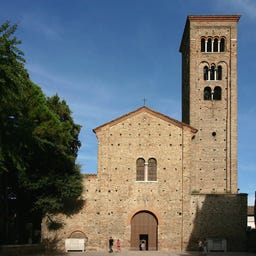
The Basilica di San Francesco in the historic center of Ravenna uniquely combines medieval architecture with literary significance. In the three-nave church from the 9th/10th century, Dante Alighieri was buried in 1321, making it an important part of the city's Dante Zone.
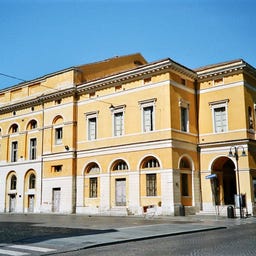
In the historic center of Ravenna, you will find the Teatro Dante Alighieri, the city's most important theater, which was grandly opened in 1852 with Giacomo Meyerbeer's "Roberto il diavolo."
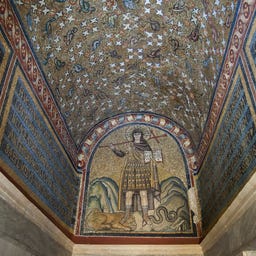
In the Archbishop's Chapel of Ravenna, you will find one of the best-preserved Orthodox buildings from the time of the Ostrogoth king Theodoric the Great. Built in 495 AD, the chapel, which is now located on the first floor of the Archbishop's Museum, captivates with its unique mosaics featuring early Christian themes.
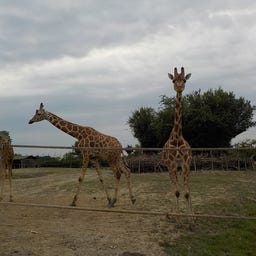
In the Safari Ravenna, you experience Italian wilderness over 340,000 square meters, where you can observe large mammals and birds up close. On the 4-kilometer safari route, you drive through expansive enclosures in your own car or a park vehicle, without any disturbing barriers between you and the animals.
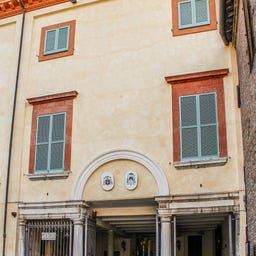
In the oldest diocesan museum in Italy, located in the historic Palazzo Arcivescovile in Ravenna, you will find an impressive collection of religious art from the 5th to the 13th century. Founded in 1734, the museum houses precious treasures in four exhibition rooms, including the 6th-century ivory Cattedra vescovile and significant Byzantine artworks.
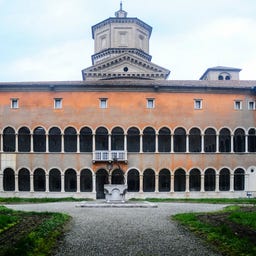
In the magnificent Renaissance complex of the Loggetta Lombardesca, the MAR houses over 300 significant artworks from the 14th to the 20th century, including the famous tombstone of Guidarello Guidarelli by Tullio Lombardo from 1525.
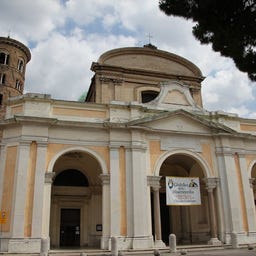
In the heart of Ravenna's old town stands the impressive Duomo di Ravenna, built in the 18th century in a Baroque-Classical style, continuing a tradition as a bishop's seat that spans over 1300 years. The current structure, officially called the Cathedral of the Resurrection of Our Lord Jesus Christ, was constructed between 1734 and 1745 on the site of an early Christian basilica and is part of an impressive church complex that includes the Archbishop's Palace and the Neonian Baptistery.
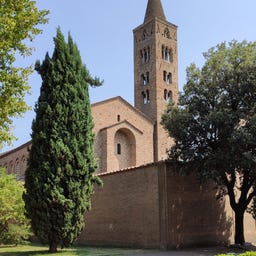
As the oldest church in Ravenna, the Chiesa di San Giovanni Evangelista takes you on a journey through time from the 5th to the 14th century, showcasing various architectural styles from early Christian to Gothic, as commissioned by Galla Placidia. The impressive bell tower from the 10th century houses some of the oldest signed bells in Italy and rises 42 meters high. Inside, you will find three naves adorned with Byzantine capitals, Gothic frescoes, and a remarkable mosaic floor from the 12th century. Despite suffering severe damage during World War II, the church was faithfully restored and continues to serve as an active place of worship today.
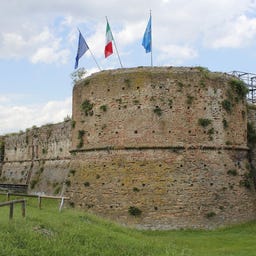
The powerful Rocca Brancaleone was built by the Venetians between 1457 and 1470 as a northeastern defense post for Ravenna. This impressive fortress complex consists of two main parts - the actual fortress and the barracks - and today it houses a public park that spans 17,000 m².
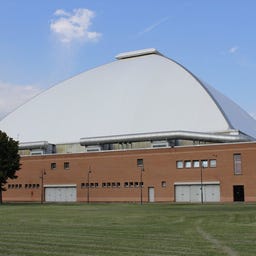
In the heart of Ravenna, you'll find the Il Pala De André, a multifunctional arena that has hosted both sports events and concerts since its opening in 1990. Designed by architect Carlo Maria Sadich, the hall features a distinctive semi-dome shape and accommodates 3,500 spectators. As you approach the entrance, you'll notice the impressive sculpture "Il Grande Ferro R" by Alberto Burri, inspired by an inverted ship's hull. Originally built by Raul Gardini in memory of Mauro De André, the arena is now not only the home ground for local volleyball and basketball teams but also a popular venue for orchestral concerts and art exhibitions, thanks to its unique acoustic shell.
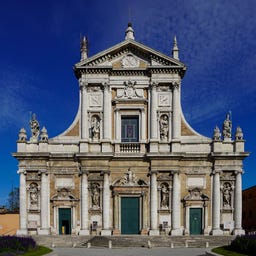
The impressive Basilica di Santa Maria in Porto has shaped the skyline of Ravenna since the 16th century and houses one of the oldest Eastern representations of Mary, the Byzantine Greek Madonna. The white marble structure, featuring a façade designed by Camillo Morigia made of Istrian stone, has a tumultuous history—from being looted by French troops in 1797 to serving as a military barracks.
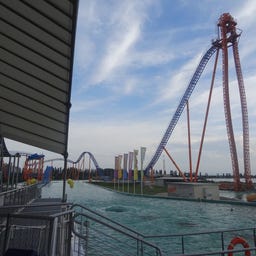
At the Italian amusement park Mirabilandia, you can experience DiVertical, the highest water roller coaster in the world. Built by the Swiss company Intamin, this ride catapults you to a height of 60 meters and reaches speeds of up to 110 km/h. During the three-minute ride, you'll encounter a mix of steep drops with inclines of up to 45 degrees and spectacular water elements. Opened in 2012, this attraction impresses with its unique offshore racing boat design and doesn't include any inversions, making it accessible to a wide audience.
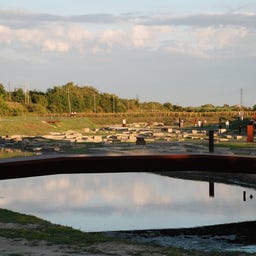
In the ancient port center Civitas Classis, which Augustus founded around 27 BC as a military harbor to control the eastern Mediterranean, you will find a vast archaeological park today with impressive remains of the Roman harbor facilities. The once-great port, which could accommodate up to 250 warships, was connected to the Adriatic Sea by an artificial canal and experienced a second flourishing as a trading port after its military decline in the 4th century.
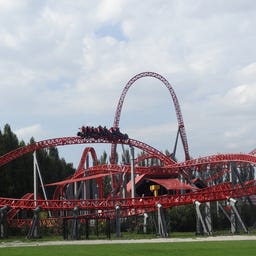
With an acceleration from 0 to 100 km/h in just 2.2 seconds, the iSpeed catapults you into the air at the Mirabilandia amusement park. Opened in 2009 by Marco Simoncelli, this roller coaster reaches a top speed of 120 km/h over its 1000-meter track, making it the fastest roller coaster in Italy.
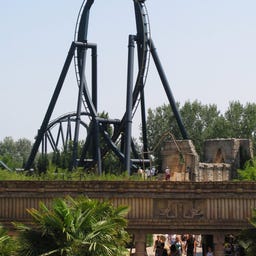
At the Italian amusement park Mirabilandia, you can experience Katun, Europe's longest and most acclaimed inverted roller coaster. Built by the Swiss company Bolliger & Mabillard, this ride has been launching you at speeds of up to 104 km/h through six inversions since 2000, reaching a maximum height of 52 meters.
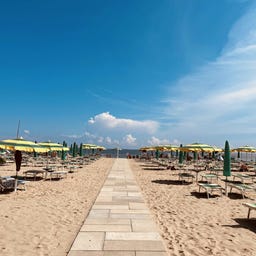
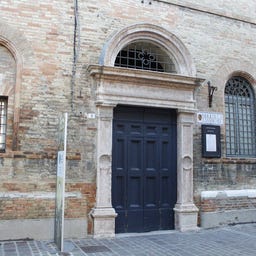
In the historic Biblioteca Classense in Ravenna, you will find one of the most significant libraries in Italy, with around 850,000 volumes. The history of this impressive building dates back to 1512, when monks stored their valuable manuscripts here after the Battle of Ravenna.

On the Via di Roma in Ravenna, you will find the historical remains of the Palazzo di Teodorico, whose true history is still not fully understood. Although the name refers to the famous Ostrogoth king, the masonry likely dates back to the 7th or 8th century and could have been part of a palace complex for the Byzantine city governors.
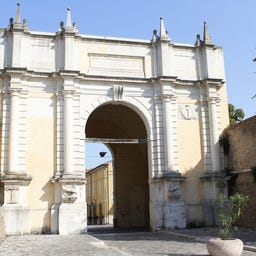
The Porta Adriana, also known as Port'Aurea Nova, is one of the historic city gates of Ravenna, located at the western end of Via Cavour. While the first mention of the original gate dates back to the 11th century, the current structure was commissioned by Cardinal Guido Luca Ferrero in 1582 and completed just a year later.
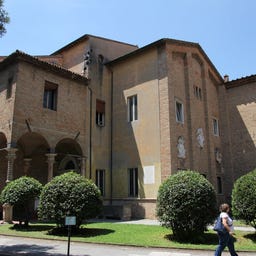
In the former Benedictine Monastery of San Vitale, you will find one of the most significant museums in Ravenna, which has its origins in the collecting passion of the Camaldolese monks, particularly Pietro Canneti. The impressive collection includes archaeological finds from the Bronze Age to the Byzantine period, as well as one of the most important collections of ivory in Italy, featuring the famous Murano Diptych from the 6th century. You should also take a look at the nearly 200 religious icons in the Cretan-Venetian style and the extensive collection of weapons from the 15th to 17th centuries. Founded as a municipal museum in 1804 and becoming a state institution in 1887, it also showcases a remarkable collection of Roman, early Christian, and medieval stonework.
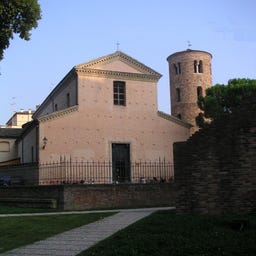
The Chiesa di Santa Maria Maggiore, built in the 6th century, combines early Christian and Baroque architectural elements into a fascinating whole. The original central layout was transformed in the 17th century by architect Pietro Grossi into a three-nave basilica, supported by Corinthian columns. A particularly striking feature is the cylindrical bell tower from the 9th/10th century, which rises near the Basilica San Vitale. Inside, you'll find not only the magnificent main altar made of multicolored marble but also art historical treasures like a painting by Luca Longhi and a Roman sarcophagus.
North of Ravenna lies the Pialassa della Baiona, a fascinating brackish lagoon system with a network of fishbone-like channels covering 1,100 hectares. This protected natural landscape, which emerged from a large bay in the 18th century, is now part of the Parco regionale del Delta del Po and recognized as an internationally significant wetland.
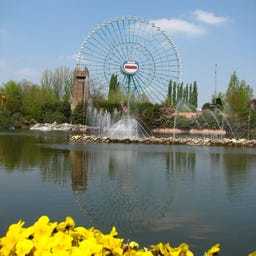
Standing at 92 meters tall, the Eurowheel has been an impressive landmark over the amusement park Mirabilandia since 1998. In the 50 cabins, which can hold 4-5 people each, you can enjoy a spectacular panoramic view of the park, the pine forests, and the nearby beaches during the 18-minute ride.
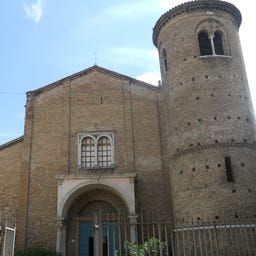
The Basilica di Sant'Agata Maggiore is one of the oldest churches in Ravenna, built in the 5th century under Bishop Pietro II. Located close to Dante's Tomb, this sacred building combines early Christian and Renaissance elements, including a striking bell tower from 1560.

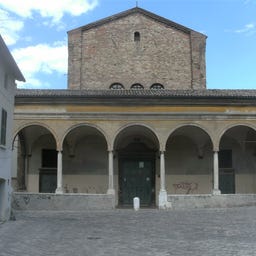
In the Church of the Holy Spirit, you encounter one of the most significant testimonies of Arian faith in early Ravenna. The church was founded in the early 6th century by Theodoric the Great and was originally dedicated to the Holy Resurrection (Hagìa Anastasis).
Just 10 km north of Ravenna, you’ll find Punte Alberete, one of the last remaining original swamp forest areas in the Po Valley. This internationally significant wetland, protected under the Ramsar Convention since 1977, has formed from the dammed waters of the Lamone River.
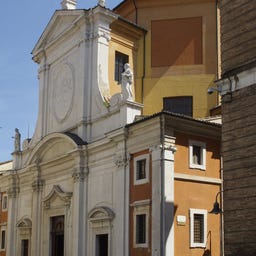
The baroque Chiesa di Santa Maria del Suffragio has been a defining feature of the central Piazza del Popolo in Ravenna since the early 18th century. This octagonal church, built between 1701 and 1728 by the Brotherhood of the Blessed Virgin of the Suffrages, impresses with its elegant facade made of Istrian stone.
In a former sugar factory in the Classe district, you can discover the fascinating history of Ravenna and its region since 2018. The modern museum showcases over 600 historical artifacts - from ancient amphorae and coins to impressive mosaics like the "Pugilist" from the 1st century BC.
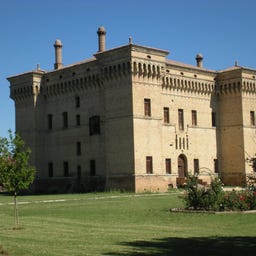
In the northern Italian town of Castiglione di Ravenna stands the Palazzo Grossi, an impressive blend of Renaissance palace and 16th-century fortification. Built by Count Pietro Grossi between 1560 and 1565, this brick structure captivates with its square layout and distinctive corner towers, constructed on the foundations of an older fortress.
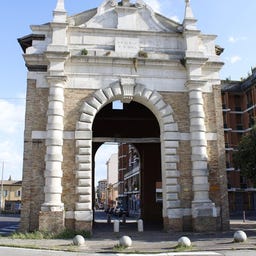
The Porta Serrata in the northern city wall of Ravenna is a fascinating testament to a tumultuous history: Its name "Closed Gate" recalls the time when the original passage was sealed by the Venetians for military reasons.
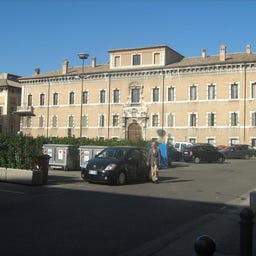
The impressive Palazzo Rasponi dalle Teste dominates the skyline of Ravenna with its 70-meter-long facade and distinctive central tower. Built in the late 17th century by brothers Giovanni and Giuseppe Rasponi, the palace gets its nickname from the numerous sculpted faces on the facade, completed in 1738, including lion heads and masked Moorish faces.
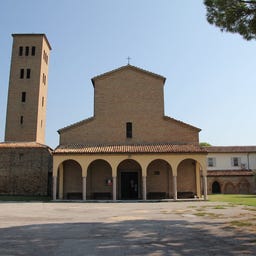
The Chiesa di Santa Maria in Porto Fuori has a rich history that dates back to the early 12th century and may even have been mentioned by Dante Alighieri in his "Divine Comedy." Originally the seat of the Regular Canons of Santa Maria in Porto, the church developed into an important religious center, especially for the veneration of the Madonna Greca.
The Bacino della Standiana is a rectangular brackish water basin measuring an impressive 2500 × 700 meters, located near Ravenna. As the largest remaining wetland of the former Standiana lowland, the lake was created in the early 20th century as part of drainage works.
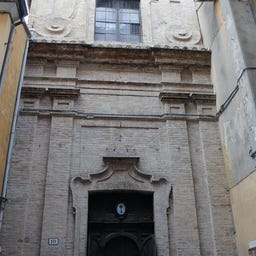
Just a few steps away from the Basilica San Francesco, you will find the Chiesa di Santa Maria Maddalena, a charming Baroque church from the mid-18th century. Designed by Fausto Pellicciotti between 1748 and 1750, the building stands on the historic foundations of Santa Maria in Luminaria, which was already mentioned in documents in 1076.
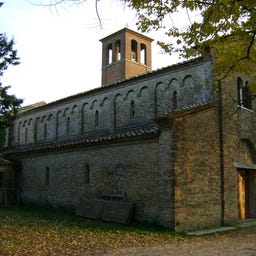
The "Pieve di San Pietro in Trento" is located in the homonymous district of the municipality of Ravenna, but within the diocese of Forlì. The toponym "in Trento, in Trentula" or the earlier "Trigintula" is due to the location of the church, at the thirtieth mile of the Roman centuriation.
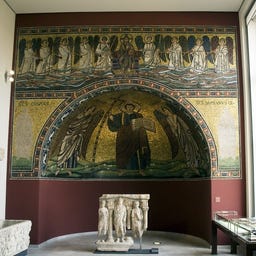
The Chiesa di San Michele in Africisco, founded in the 6th century by Giuliano Argentario and his son-in-law, is one of the most significant Byzantine church buildings in Ravenna. This three-nave structure, built in the Greek-Constantinopolitan style, once housed magnificent mosaics, the most famous of which—the apse featuring Christ and the archangels—is now on display at the Bode Museum in Berlin.
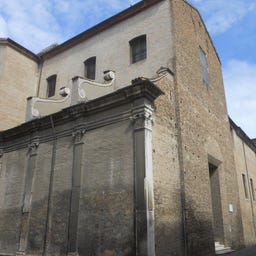
The "Church of San Romualdo" is located in the historic center of Ravenna, at the intersection of Via Alfredo Baccarini and Via Nicolò Rondinelli; it is closed to worship but not desecrated, and it falls within the territory of the parish of Sant'Agata Maggiore, of the Archdiocese of Ravenna-Cervia, but it is owned by the municipality.

The "Casa del Mutilato," or "Casa del Mutilato di Guerra," or "Palazzo del Mutilato" is a building located in Piazza John Fitzgerald Kennedy in Ravenna.
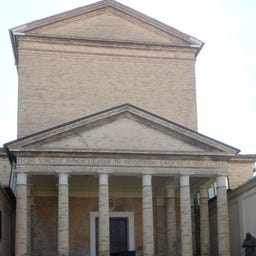
The "Church of San Rocco" is a Catholic place of worship in the city of Ravenna, in Emilia-Romagna, and is the seat of the namesake parish, one of the most populous in the Archdiocese of Ravenna-Cervia.
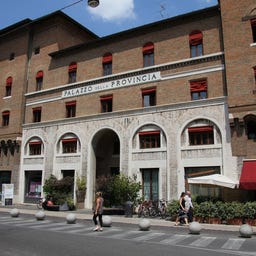
The "Palazzo della Provincia" is a palace from the 1920s in Ravenna, in the Italian region of Emilia-Romagna. It is located at "Piazza San Francesco 1" and today houses the crypt of the "Rasponis" and the hanging gardens.
The "Castello di Mercabò" or "Marcabò" or "Marcamò" was a fortress built by the Venetians between 1258 and 1260 to defend their trade routes on the Po di Primaro.
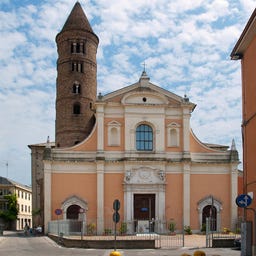
In the historic center of Ravenna, you will find the Chiesa di San Giovanni Battista, which dates back to the 6th century. After it was destroyed by a devastating earthquake in 1688, the church was rebuilt the following year as a three-nave basilica in Baroque style. The impressive bell tower from the 9th-10th century and parts of the original apse have withstood the test of time and still testify to the early architectural history of the church.
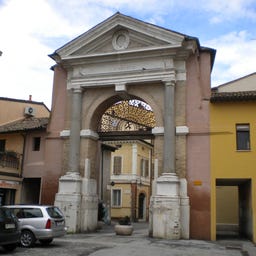
The Porta Sisi is one of the four historical city gates of Ravenna and has connected the old town with Borgo San Rocco since the 10th century. As a magnificent ceremonial entrance for new archbishops, the gate took on its current form through extensive renovations in the 16th and 17th centuries, featuring the characteristic Doric column architecture with granite columns.
"Ortazzo, Ortazzino, Foce del Torrente Bevano" is a site of community interest and a special protection area in the province of Ravenna.
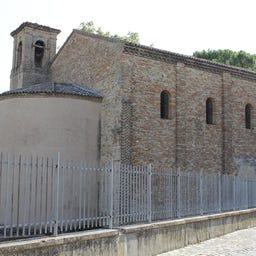
The Chiesa di Santa Croce in Ravenna is one of the most significant church buildings from the 5th century, constructed by the Roman Empress Galla Placidia between 417 and 421. With its unusual Latin cross layout for Ravenna and elaborate marble decorations, the church reflects the early Christian architectural style. The Mausoleum of Galla Placidia, originally part of the church, was accessible through the narthex before the church underwent significant changes due to several renovations starting in the 14th century. Today, you can find the partially preserved church in the historic northeastern part of Ravenna, where it, along with an ancient amphitheater, is part of an important archaeological site.
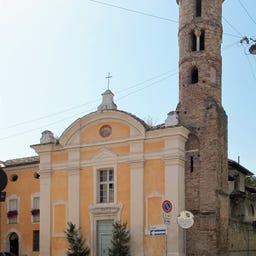
The "Church of Saints John and Paul," also known as the "Church of the Guardian Angels," is a Catholic place of worship located in the historic center of Ravenna.
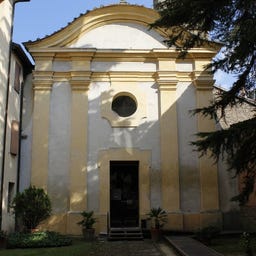
The "Church of Sant'Eufemia" is a religious building in the city of Ravenna located on Via Barbiani, in the city center.
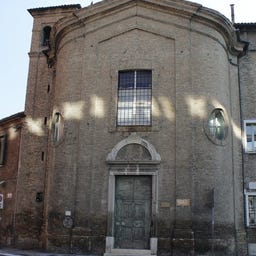
The "Church of Santo Stefano degli Ulivi" is a former Catholic place of worship located in Piazza Mameli, in the historic center of Ravenna.
The "Lake of Ghiarine" is an artificial body of water located in the municipality of Ravenna, between the districts of Fosso Ghiaia and Classe.
The "Church of Sant'Apollinare in Veclo" is a Catholic place of worship in the city of Ravenna. Along with the Church of San Carlino and the Church of Santa Maria Maddalena, it is one of the smallest active places of worship in the city.
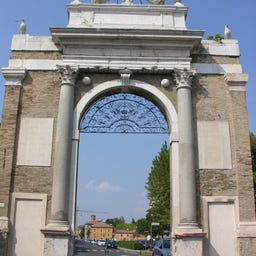
"Porta Nuova," also known as "Porta Gregoriana" or "Porta Pamphilia," is a monumental gate in Ravenna, located at the southern end of Via di Roma, in the southern part of the city.
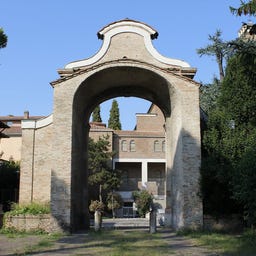
"Porta Gaza" is a gate in the city walls of Ravenna.
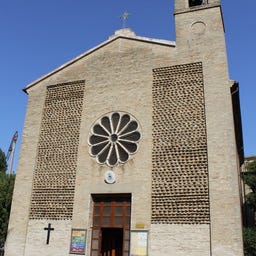
The "Church of San Biagio" is a Catholic place of worship in the city of Ravenna, in Emilia-Romagna, home to the parish of the same name that belongs to the Archdiocese of Ravenna-Cervia.
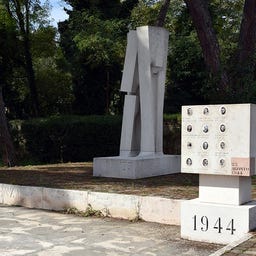
The "Monument Complex Tribute to the Resistance" was created by Giò Pomodoro in 1980. It is located at the intersection of Via Nullo Baldini, Via Piave, and Via Mura di Porta Gaza in Ravenna, where the Bridge of the Allocchi once stood. The monument was erected in memory of the brutal massacre at the Bridge of the Allocchi, later named the Bridge of the Martyrs.
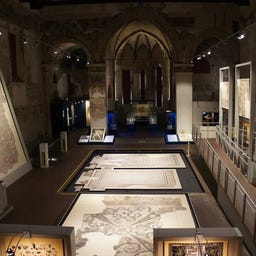
"All the Adventure of Mosaic" was a permanent exhibition entirely dedicated to the art of mosaic, which took place from 2011 to 2023 within the ancient church of San Nicolò in Ravenna. The exhibition, inaugurated on May 20, 2011, and open to the public the following day, was promoted by the RavennAntica Foundation, the Municipality of Ravenna, the Emilia-Romagna Region, and the Department of Archaeology at the University of Bologna. The curator of the exhibition was Professor Carlo Bertelli.
The "Pineta di Ravenna Nature Reserve" is a protected natural area located in the province of Ravenna and covers an area of 709 hectares, within the Pineta di Ravenna.
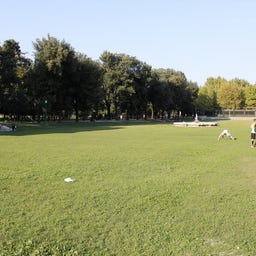
The "public gardens of Ravenna" are located on Viale Santi Baldini, situated in the southeastern part of the city center.
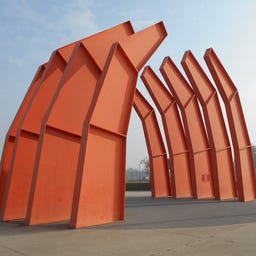
In front of the Palazzo Mauro De André in Ravenna stands the striking steel sculpture "Il Grande Ferro R," created by Alberto Burri in 1990 as a site-specific artwork. This monumental installation, reminiscent of an overturned ship's hull, was commissioned by Raul Gardini and symbolizes the connection between Ravenna and the nearby pine forest of Lido di Classe.
The "Duna costiera ravennate e foce torrente Bevano Nature Reserve" is a protected natural area located in the province of Ravenna. The protected area is the coastal strip of natural dunes stretching from Lido di Dante in the north to Lido di Classe in the south. It is part of the wetland area of Ortazzo and Ortazzino.
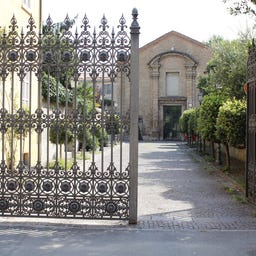
The "Luigi Rasi Theatre" is a small prose theatre located in the center of Ravenna. Built in the last decade of the 19th century in the former monastic church of Santa Chiara, since 1991 the Rasi has been the home of Ravenna Teatro, a theatre production center founded by the theatre companies Teatro delle Albe and Drammatico Vegetale.
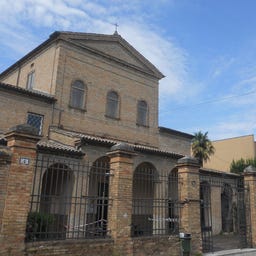
The "Church of Santa Maria degli Angeli" is a Catholic place of worship located in the center of Ravenna, at via Oberdan 6. It is the seat of the namesake rectory, which falls within the territory of the parish of San Giovanni in Fonte.
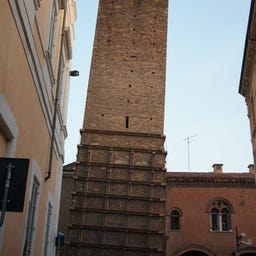
The "Teatro Socjale" is an Italian theater located in Piangipane.
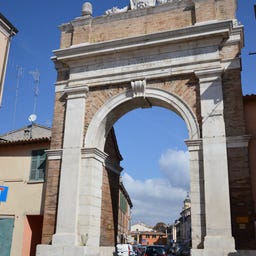
The "Portonaccio" or "Portone" is a simple urban gate from the medieval period, consisting of an arch resting on piers. In numerous texts, it is identified as a triumphal arch that connects via Ravegnana to via Castel San Pietro, and along with porta Sisi, it is the main passage to enter Borgo San Rocco, one of the historic districts of Ravenna. The name derives from "Portunaz," used in the Ravenna dialect to indicate a gate in a state of abandonment.
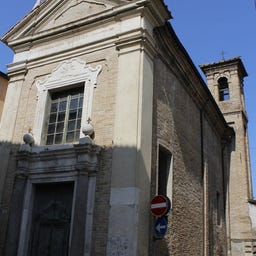
The "Church of San Carlino" is a religious building in the city of Ravenna located on Via Tombesi dall'Ova, near the Basilica of Sant'Agata Maggiore.
The "Dante Center of the Conventual Franciscan Friars" is a cultural activity of the same Order, a religious entity recognized by the state with R.D. March 7, 1932. It was inaugurated in Ravenna by Father Severino Ragazzini in 1964, on the eve of the VII Centenary of the birth of Dante Alighieri.
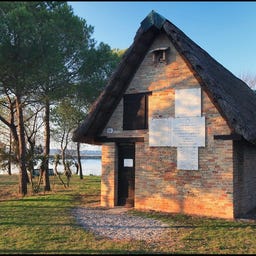
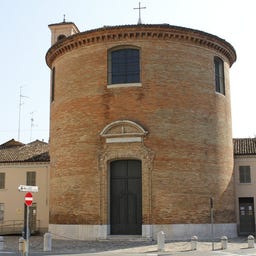
The small but charming Chiesa di Santa Giustina in the historic center of Ravenna impresses with its unusual cylindrical shape and exquisite Baroque architecture from the 18th century. Designed by Giovan Francesco Buonamici, this sacred building features a magnificent marble altar from 1746 and a significant painting by the artist Francesco Longhi from the 16th century.
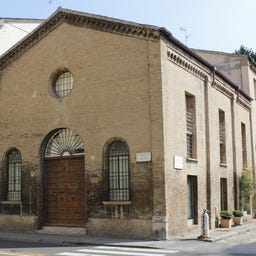
The "Church of Santa Barbara" was a religious building in the city of Ravenna located on Via di Roma, near the Basilica of Sant'Apollinare Nuovo.
